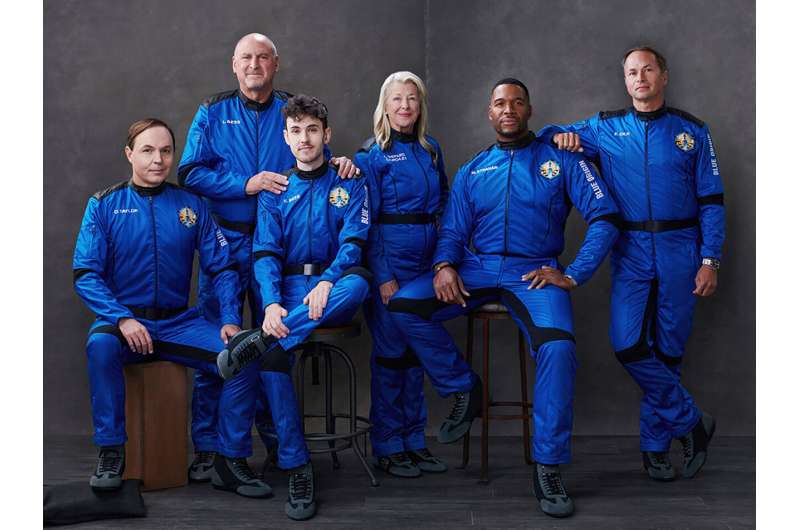
Copernical Team
Bezos' Blue Origin completes third crewed space flight

Jeff Bezos' Blue Origin company blasted its third private crew into space on Saturday and brought it back safely, this time including the daughter of the first American astronaut.
The stubby white spacecraft with a round tip blasted off into clear blue skies over West Texas for a roughly 11-minute trip to just beyond the internationally recognized boundary of space, 62 miles (100 kilometers) high.
The six-member crew hooted with glee as they unbuckled to enjoy a few minutes of weightlessness, looking out at space through tall windows in the capsule.
"I've never seen anything like that," one unidentified crew member said as Blue Origin livestreamed the flight.
Daughter of first American astronaut launches on Blue Origin flight
 Jeff Bezos' Blue Origin company blasted its third private crew to space on Saturday, this time including the daughter of the first American astronaut.
The stubby white spacecraft with a round tip blasted off into clear blue skies over West Texas for a roughly 11 minute trip to just beyond the internationally-recognized boundary of space, 62 miles (100 kilometers) high.
The six-member cre
Jeff Bezos' Blue Origin company blasted its third private crew to space on Saturday, this time including the daughter of the first American astronaut.
The stubby white spacecraft with a round tip blasted off into clear blue skies over West Texas for a roughly 11 minute trip to just beyond the internationally-recognized boundary of space, 62 miles (100 kilometers) high.
The six-member cre Blue Origin poised to send NFL, TV's Strahan into space

Jeff Bezos' rocket company, Blue Origin, is about to send former NFL great Michael Strahan into space—with a football.
The co-host of ABC's "Good Morning America" and former New York Giant prepped Saturday for a morning blastoff from West Texas. Five others will join him on the 10-minute flight, including the eldest daughter of the first American in space, Alan Shepard. Blue Origin's New Shepard rocket is named for him.
New space economy ready to lift off thanks to Finnish innovation
 The new space economy is taking a giant leap as space technology turns towards improving the future of life here on earth. As the sector grows, innovative Finnish companies are leading the way using their digital and tech-savvy expertise as well as stellar engineering skills to bring space back down to earth.
According to Morgan Stanley's Space Team the global space industry will surge to
The new space economy is taking a giant leap as space technology turns towards improving the future of life here on earth. As the sector grows, innovative Finnish companies are leading the way using their digital and tech-savvy expertise as well as stellar engineering skills to bring space back down to earth.
According to Morgan Stanley's Space Team the global space industry will surge to A young, sun-like star may hold warnings for life on Earth
 Astronomers spying on a stellar system located dozens of lightyears from Earth have, for the first time, observed a troubling fireworks show: A star named EK Draconis ejected a massive burst of energy and charged particles in an event that was much more powerful than anything scientists have seen in our own solar system.
The researchers, including astrophysicist Yuta Notsu of the Universit
Astronomers spying on a stellar system located dozens of lightyears from Earth have, for the first time, observed a troubling fireworks show: A star named EK Draconis ejected a massive burst of energy and charged particles in an event that was much more powerful than anything scientists have seen in our own solar system.
The researchers, including astrophysicist Yuta Notsu of the Universit You can help scientists study the Sun
 If you ever wanted to be an astronomer, now is your chance. A new citizen science project, led by researchers at the University of Minnesota with support from NASA, allows volunteers to play an important role in learning more about the Sun by using their personal computers.
Participants will help identify bursts of plasma coming off the Sun, called solar jets, in thousands of images captur
If you ever wanted to be an astronomer, now is your chance. A new citizen science project, led by researchers at the University of Minnesota with support from NASA, allows volunteers to play an important role in learning more about the Sun by using their personal computers.
Participants will help identify bursts of plasma coming off the Sun, called solar jets, in thousands of images captur Machine Learning decodes Tremors of the Universe
 Black holes are one of the greatest mysteries of our Universe - for example a black hole with the mass of our Sun has a radius of only 3 kilometers. Black holes in orbit around each other give off gravitational radiation - oscillations of space and time predicted by Albert Einstein in 1916. This causes the orbit to become faster and tighter, and eventually the black holes merge in a final burst
Black holes are one of the greatest mysteries of our Universe - for example a black hole with the mass of our Sun has a radius of only 3 kilometers. Black holes in orbit around each other give off gravitational radiation - oscillations of space and time predicted by Albert Einstein in 1916. This causes the orbit to become faster and tighter, and eventually the black holes merge in a final burst Research reveals how plasma swirling around black holes can produce heat and light
 Researchers at the U.S. Department of Energy's (DOE) Princeton Plasma Physics Laboratory (PPPL) have uncovered a process in the swirling masses of plasma surrounding black holes and neutron stars that can cause previously unexplained emissions of light and heat.
The process, known as magnetic reconnection, also jettisons huge plumes of plasma billions of miles in length. These findings can
Researchers at the U.S. Department of Energy's (DOE) Princeton Plasma Physics Laboratory (PPPL) have uncovered a process in the swirling masses of plasma surrounding black holes and neutron stars that can cause previously unexplained emissions of light and heat.
The process, known as magnetic reconnection, also jettisons huge plumes of plasma billions of miles in length. These findings can WVU engineers creating software for aerobots to explore Venus
 Engineers at West Virginia University are propelling exploration forward by creating control software for a group of aerial robots (aerobots) that will survey the atmosphere of Venus, the second planet from the sun.
According to researchers, Venus went through a climate change process that transformed it from an Earth-like environment to an inhospitable world. Studying Venus can help model
Engineers at West Virginia University are propelling exploration forward by creating control software for a group of aerial robots (aerobots) that will survey the atmosphere of Venus, the second planet from the sun.
According to researchers, Venus went through a climate change process that transformed it from an Earth-like environment to an inhospitable world. Studying Venus can help model Mars helicopter to sit dormant until radio contact restored
 NASA's Mars helicopter may have to wait days to overcome a blocked radio signal caused by hills between it and the Perseverance rover in Jezero Crater, a NASA official said.
Until then, the tiny helicopter that has captured the imagination and attention of people around the globe will sit quietly, charging its solar-powered batteries, Teddy Tzanetos, Ingenuity program lead, said in an i
NASA's Mars helicopter may have to wait days to overcome a blocked radio signal caused by hills between it and the Perseverance rover in Jezero Crater, a NASA official said.
Until then, the tiny helicopter that has captured the imagination and attention of people around the globe will sit quietly, charging its solar-powered batteries, Teddy Tzanetos, Ingenuity program lead, said in an i 